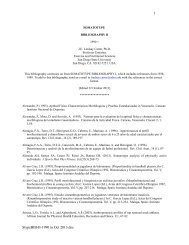THE HEATH-CARTER ANTHROPOMETRIC ... - Somatotype.org
THE HEATH-CARTER ANTHROPOMETRIC ... - Somatotype.org
THE HEATH-CARTER ANTHROPOMETRIC ... - Somatotype.org
Create successful ePaper yourself
Turn your PDF publications into a flip-book with our unique Google optimized e-Paper software.
<strong>Somatotype</strong> Instruction Manual 6<br />
(12) Obtain height divided by cube root of weight (HWR). Record HWR in the appropriate box.<br />
(13) Circle the closest value in the HWR table to the right. (See note in number (4) above.)<br />
(14) In the row for ectomorphy circle the ectomorphy value directly below the circled HWR.<br />
(15) Move to the bottom section of the rating form. In the row for Anthropometric <strong>Somatotype</strong>, record<br />
the circled ratings for Endomorphy, Mesomorphy and Ectomorphy.<br />
(16) Sign your name to the right of the recorded rating.<br />
The identification data in the upper section of the rating form are somewhat arbitrary.<br />
Investigators may change these to suit their purposes.<br />
Principles of the calculations<br />
Two principles are important in understanding the calculation of mesomorphy on the rating form.<br />
(1) When the measurements of bone breadths and limb girths lie to the right of the circled height column,<br />
the subject has greater musculo-skeletal robustness relative to height (i.e. higher mesomorphy) than a<br />
subject whose values lie to the left of the height column. The average deviation of the circled values for<br />
breadths and girths is the best index of average musculo-skeletal development relative to height. (2)<br />
The table is constructed so that the subject is rated 4 in mesomorphy when the average deviation falls in<br />
the column under the subject's height, or when the four circled values fall in the subject's height column.<br />
That is, the average deviation (±) to the left or right of the height column is added to or subtracted from<br />
4.0 in mesomorphy.<br />
Height-Weight ratio calculation<br />
The height-weight ratio (HWR), or height divided by the cube root of weight (stature/mass 1/3 )<br />
as it is used in somatotyping, may be determined by using a hand calculator. A calculator with a y to the<br />
x power (y x ) key is needed. To get the cube root, enter mass, i.e. base (y), press y x , enter .3333, and<br />
press 'equals'. If there is an INV y x function, this may be used instead by entering 3 (for the cube root).<br />
Limitations of the rating form<br />
Although the rating form provides a simple method of calculating the anthropometric<br />
somatotype, especially in the field, it has some limitations. First, the mesomorphy table at the low and<br />
high ends does not include some values for small subjects, e.g. children, or for large subjects, e.g. heavy<br />
weightlifters. The mesomorphy table can be extrapolated at the lower and upper ends for these<br />
subjects. Second, some rounding errors may occur in calculating the mesomorphy rating, because the<br />
subject's height often is not the same as the column height. If the anthropometric somatotype is regarded<br />
as an estimate this second limitation is not a serious problem. Nevertheless, the following procedures<br />
described in Carter (1980) and Carter and Heath (1990) can correct these problems.<br />
B. Equations for a decimal anthropometric somatotype<br />
The second method of obtaining the anthropometric somatotype is by means of equations into<br />
which the data are entered.<br />
endomorphy = - 0.7182 + 0.1451 (X) - 0.00068 (X 2 ) + 0.0000014 (X 3 )<br />
where X = (sum of triceps, subscapular and supraspinale skinfolds) multiplied by (170.18/height in cm).<br />
This is called height-corrected endomorphy and is the preferred method for calculating endomorphy.<br />
3/19/2003




